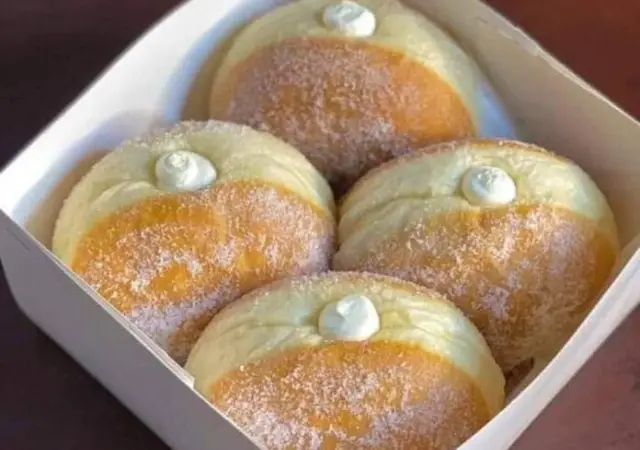Milky Donut has recently captured the hearts and taste buds of many Nigerians. Overnight, these sweet delights flooded social media feeds, sparked scintillating reviews from bloggers, and even found their way into national health advisories. But what sparked this sudden frenzy, and what deeper sociological implications lie behind the milky donut phenomenon?
Donuts are common snacks for school children in Nigeria. It is mostly considered inferior to cakes and pies which are richer in protein content and prestige. It is therefore very curious to see many Nigerians excited to join the bandwagon of Milky Donuts celebration.
At first glance, it’s easy to attribute the appeal of milky donuts to their creamy outer layer, enticing both the eyes and the palate. The addition of milk paste undoubtedly adds a texture and rich flavor. Making them an irresistible indulgence for many Nigerians. However, is it merely the taste that drove this craze, or is there more to the story?
The current economic realities of Nigeria definitely have a role to play in the rise of milky donuts. The price of foodstuffs has been rising unabated. Earlier this year, a kilogram of milk was sold for 7,000 naira as against the 2,000 naira just three years ago. Milk recorded a 300% rise in such a short span. This necessitated the rise in the price of milky donuts from 1,500 naira for a box of six to as high as 9,000 for the same box this year.

This new rise in the price of donuts suddenly lifted milky donuts from being an inferior snack to being a snack worthy of all Nigerian classes. I remember back in 2017 when a certain Twitter user wrote about buying a pack of donuts for 8,000 naira and he received serious backlash from Nigerians as a liar and a fake wannabe.
Now, the price that was inconceivable 7 years ago has become a reality. It is therefore understandable why social media is agog about Milky donuts. This is because they are now being sold for a price that could, just a few years ago pass as a lie. This is perfectly in line with the fake it until you make it personality of some Nigerians.
Again, by searching deeper for reasons why milky donuts reigned, we uncover some intricate social dynamics at play. Nigeria is a country where food is not just sustenance but a cornerstone of cultural celebrations and social gatherings. This is why milky donuts found their place as a perfect gift for festivities like Eid-Il-Fitr. Housewives, in particular, seized upon this convenient and delectable treat as a gesture of love and celebration for friends and family.
But beyond the surface-level festivities, the impact of food on Nigerian households’ sociology is profound. Food acts as a unifier, bringing people together in shared experiences and traditions. The exchange of milky donuts during celebrations serves as a symbol of unity and generosity, reinforcing social bonds within communities.
There is a deep symbolism for donuts to serve as a unifier of communities and Nigerians on social media. The shape of the donut is a perfect circle which in philosophical terms depicts unity, endless connection and continuity of things. It was observed that during the online frenzy of milky donuts on social media, all Nigerians regardless of religion and tribe equally and joyfully participated in the trend.
Yet, amidst all this frenzy, a darker concern remains true. The need to “feel among” and succumb to peer pressure undoubtedly played a role in the milky donut craze. In a society where status and social acceptance hold significant sway, the allure of participating in a trending phenomenon can be irresistible.
The peer pressure of the 21st century happens mostly on social media. People tend to want to feel among and as such they may have been influenced to order for milky donuts. For the sake of snapping and posting on their social feeds to feel among. This problem transcends beyond food. All aspects of Nigerian social media life is affected. For example, it is common to find boys and girls posing in front of houses with beautiful landscapes and flowers just so they can have a presentable picture they can use on their social media. Not many Nigerians who live in local or mud houses can confidently snap pictures in their houses and share on social media.
The cancer of social media validation has eaten very deep into the fabric of Nigerian social media life. When friends go to fancy restaurants to eat, it is common to find them focusing more on snapping pictures of the food to post on their Snapchat or WhatsApp statuses. With this kind of mindset, it is no wonder the milky donut trend found many subscribers among Nigerians.
The aestheticization of food in Nigeria goes well beyond milky donuts. The creamy cover on milky donuts acts to serve a fresh layer of enticement. This aestheticization has covered all aspects of Nigerian food. Everyday, food bloggers are finding new ways to make local food into modern recipes. From cutting yams into star shapes for frying, to using food coloring in Tuwo, Nigerians are never out of ideas on how to make food about aesthetics.
While it is all fun and games, it will be important for Nigerians to be mindful of the health implications of the food innovations they keep coming up with. There is a direct relationship between junk food and some diseases. This calls for caution. Nigerians should eat healthily to live healthily. As at this moment, the life expectancy of an average Nigerian is 56.05 years. We should find ways to increase our life expectancy and not shorten it through junks.
In conclusion, the rise of milky donuts as a sensation in Nigeria is not merely a matter of taste but a reflection of deeper sociocultural dynamics. From its creamy allure to its role in cultural festivities and social dynamics, milky donuts have woven themselves into the fabric of Nigerian society. As we savor each bite of this delectable treat, let us also reflect on the complex interplay of tradition, community, and peer influence that shapes our culinary landscape.




